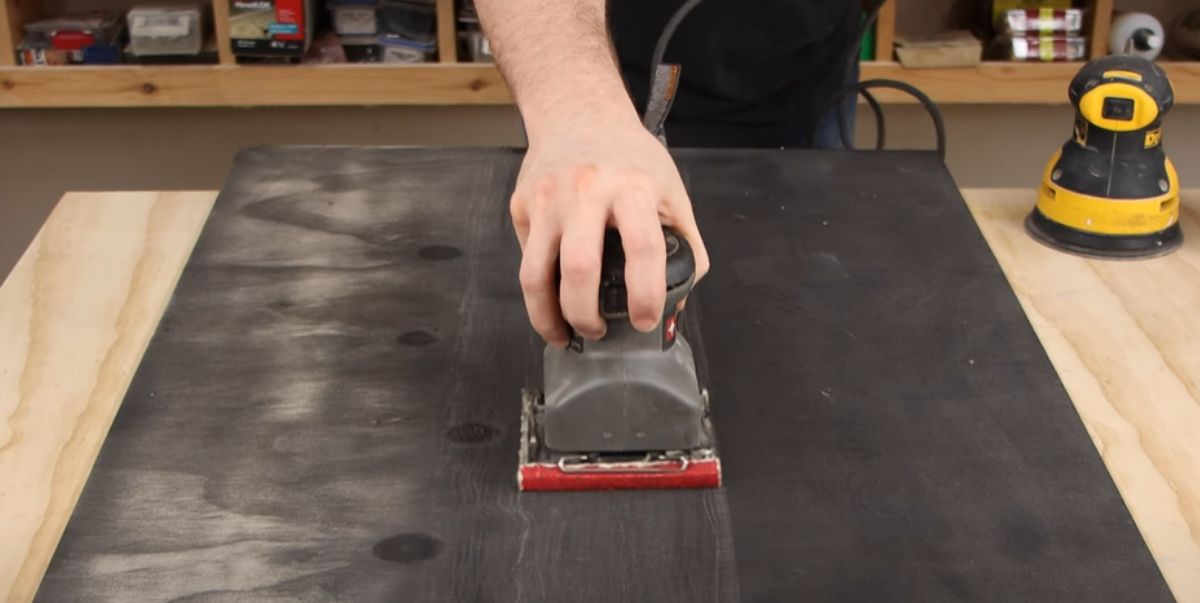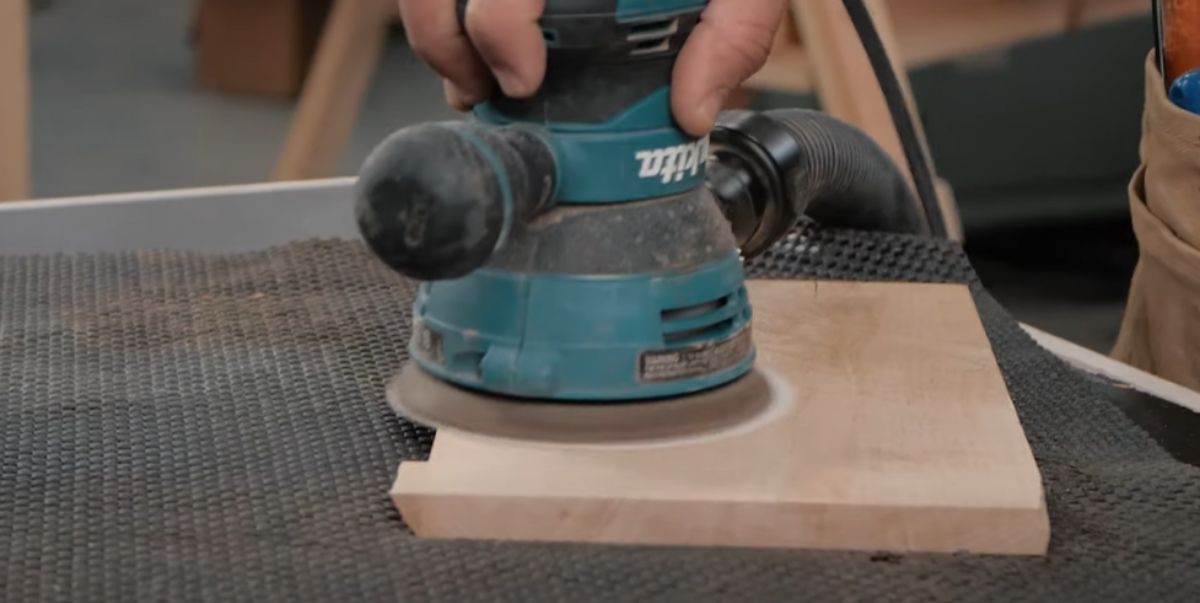To sand wood properly, start by using coarse sandpaper to remove any imperfections or rough surfaces. Gradually move to finer grit sandpaper to achieve a smooth finish.
Now, I will delve into the details of how to sand wood properly. When it comes to working with wood, achieving a smooth and polished finish is essential for any project. One of the most important steps in this process is sanding.
Whether you are refinishing furniture, preparing a wooden surface for painting, or just enhancing the natural beauty of the wood, sanding is a crucial step. However, sanding wood properly requires specific techniques to ensure the best results. We will explore the step-by-step process of sanding wood to achieve a smooth and professional finish. So, let’s begin and discover how to sand wood properly.
Selecting The Right Sandpaper Grit
Sanding wood is a crucial step in achieving a smooth and professional finish for all your woodworking projects. One of the most crucial aspects of sanding is selecting the right sandpaper grit. The sandpaper grit determines how rough or fine the sandpaper is, which directly impacts the effectiveness of the sanding process. Depending on the task at hand, you will need different grit sizes to achieve the desired results.
Understanding Grit Sizes
Grit sizes refer to the coarseness or fineness of the sandpaper. The grit number indicates the number of abrasive particles per square inch of the sandpaper. Lower numbers indicate rougher grits, while higher numbers signify finer grits. To better understand the different grit sizes available, here’s a breakdown:
| Grit Size | Description |
|---|---|
| Coarse (40-80 grit) | Used for heavy-duty sanding and removing stubborn imperfections, such as old finishes, paint, or deep scratches. Ideal for initial sanding or shaping wood surfaces. |
| Medium (100-150 grit) | Perfect for smoothing out rough surfaces and removing minor scratches. It’s an excellent choice for preparing wood for staining or applying a new finish. |
| Fine (180-220 grit) | Used for sanding bare wood to a smooth finish, removing small imperfections, and preparing surfaces for staining or painting. Provides a suitable base for further finishing. |
| Very Fine (240-400 grit) | Offers a smooth finish, ready for applying a final coat of paint or finish. Ideal for sanding between coats of paint or varnish and creating a polished surface. |
| Extra Fine (500-600 grit) | Exceptionally smooth sandpaper is used for final sanding before applying a topcoat. Primarily used for achieving a high-gloss finish on wood surfaces. |
Different Grits For Different Wood Types
It is essential to consider the type of wood you are working with when selecting the appropriate grit size. Hardwoods such as oak or maple may require a more coarse grit (40-80) for initial sanding to tackle their density. Softwoods like pine or cedar, on the other hand, are more susceptible to damage and may require a finer grit (120-180) to prevent excessive sanding.
- For a well-balanced approach, start with medium-grit sandpaper (100-150) to remove noticeable imperfections and then progress to finer grit (180-220) for a smoother finish.
- If you are applying a stain or a varnish, remember to sand with a finer grit (180-220) between coats to achieve a flawless end result.
- When working with an already smooth surface, you can start with a relatively fine grit (180-220) to save time and effort.
The key is to be aware of the wood’s characteristics and adjust your choice of grit size accordingly. Remember to always move through the grit sizes progressively for the best results. Understanding the different grit sizes and their applications will help you achieve professional-looking results and ensure a smooth and polished finish for your woodworking projects.

Preparing The Wood Surface
Before starting any woodworking project, one of the crucial steps is
preparing the wood surface. This ensures a smooth and polished finish
while also promoting the longevity of the final product. The preparation
process involves cleaning the surface and repairing any imperfections.
Cleaning The Surface
To achieve a pristine wood surface, it is essential to begin by cleaning
it thoroughly. This helps to remove dust, grime, and any other
contaminants that might interfere with the sanding process. Here’s a
simple step-by-step guide for cleaning the wood surface:
- Start by using a soft brush or vacuum cleaner to remove loose dust and
debris from the surface. This will prevent any particles from getting
trapped in the sandpaper and causing scratches. - Next, dampen a lint-free cloth with a mild wood cleaner. Gently wipe
the entire surface of the wood, ensuring you reach all the corners and
crevices. - If you encounter stubborn stains or sticky residues, use a gentle
solution of warm water and dish soap. Apply the mixture to a cloth and
scrub the affected areas gently until the stains are removed. - After cleaning, wipe the surface again with a clean, damp cloth to
remove any remaining residue. - Finally, let the wood surface dry completely before proceeding to the
next step. This will prevent moisture from interfering with the sanding
process and ensure a smooth finish.
Repairing Imperfections
Wood surfaces often have imperfections such as scratches, dents, or
holes. These need to be addressed before sanding to ensure a flawless
final result. Here are some steps to follow when repairing imperfections
in the wood:
- Inspect the surface for scratches, dents, or any other blemishes. Use a
good light source to help you identify these imperfections. - If there are minor scratches or dents, you can use wood filler to
repair them. Apply a small amount of wood filler to a putty knife and
spread it evenly over the imperfection. Allow it to dry according to
the manufacturer’s instructions before sanding. - For more substantial damage or deeper holes, consider using a wood
patch or epoxy filler. Follow the manufacturer’s instructions for
application and drying time. - Once the repairs are dry and hardened, sand the surface using fine-grit sandpaper. This will help to smooth out the repaired areas and
blend them seamlessly with the rest of the wood surface. - After sanding, wipe away any dust or debris using a clean cloth or
vacuum cleaner. Your wood surface is now ready for the final sanding
process.
Using The Correct Sanding Technique
Using the correct sanding technique is crucial for achieving a smooth and professional finish on your woodworking projects. By following the right methods, you can ensure that the wood is properly prepared for staining, painting, or polishing, and avoid common sanding errors that can compromise the final result.
Avoiding Sanding Errors
When sanding wood, it’s essential to avoid common errors that can lead to an uneven or rough finish. Ensure that the sandpaper is smooth and free from any grit or debris that could scratch the wood surface. Be mindful of the pressure you apply, and avoid exerting too much force, which can result in uneven sanding and cause damage to the wood. Additionally, take care to sand the entire surface evenly to prevent patches of over-sanded or under-sanded areas.
Sanding With The Grain
Sanding with the grain of the wood is a fundamental technique that helps to maintain the natural pattern of the wood and prevents the formation of unsightly scratches. Always sand in the direction of the grain, using long and even strokes to maintain consistency. This method will help you achieve a smooth and uniform finish while minimizing the risk of causing damage to the wood surface.
Dust Management And Safety
When it comes to sanding wood, dust management and safety should be given top priority. Proper dust extraction and wearing protective gear are essential to ensure a safe environment while sanding. In this section, we will discuss the importance of dust extraction and the protective gear required for safe sanding.
Importance Of Dust Extraction
The importance of dust extraction cannot be stressed enough when it comes to sanding wood. Sanding produces a significant amount of fine dust particles that can be harmful when inhaled. These dust particles not only pose a risk to your respiratory system but can also cause eye irritation and allergic reactions.
To effectively manage dust during the sanding process, it is recommended to use a vacuum or dust extractor that is specifically designed for woodworking. This ensures that the dust is captured at the source and does not disperse into the air, keeping the work area clean and free from floating particles.
Moreover, efficient dust extraction also improves the quality of the sanded surface. The removal of dust prevents it from settling back onto the wood, allowing for a smoother finish and better adhesion when applying finishes or coatings.
Protective Gear For Safe Sanding
Protective gear is essential to ensure safe sanding and minimize any risks associated with the process. When sanding wood, it is crucial to protect yourself from inhaling dust and avoid any physical injuries. Here are some essential protective gear items to consider:
- Dust mask or respirator: Wear a properly fitted dust mask or respirator to protect yourself from inhaling harmful dust particles. Choose a mask with a high filtration capacity to ensure maximum protection.
- Protective goggles or safety glasses: Shield your eyes from flying dust particles by wearing protective goggles or safety glasses. This prevents any potential eye irritation or injuries.
- Ear protection: Sanding can be a noisy process, so wearing ear protection such as earplugs or earmuffs is crucial to prevent hearing damage.
- Gloves: Use gloves that provide good grip and protection to avoid splinters and injuries caused by sanding abrasive surfaces.
- Long-sleeved clothing: Wear long-sleeved clothing to protect your skin from dust and potential scratches.
By wearing the necessary protective gear, you can ensure your safety and minimize any health risks when sanding wood.
Finishing Touches For Professional Results
For professional woodworking results, it’s essential to sand wood properly. Begin with coarse-grit sandpaper and gradually move to finer grits. Pay attention to the direction of the wood grains and ensure a smooth finish. Proper sanding is key to achieving professional-quality results.
Smoothing The Wood
Once you have sanded the wood to your desired level, it’s time to focus on the final touches that will bring out that professional finish. Smoothing the wood is essential to ensure a flawless surface before applying any finishes.
To smooth the wood effectively, start by lightly sanding the surface with a fine-grit sandpaper. You want to remove any remaining roughness or imperfections that could be visible once the finish is applied. Use long, even strokes, following the grain of the wood for the best results.
If there are any deep scratches or gouges on the wood, consider using wood filler to fill them in. Apply the filler according to the manufacturer’s instructions, and once it dries, sand it down until it’s flush with the rest of the surface. This will help create a smooth and consistent look.
Applying The Perfect Finish
Now that you have achieved a smooth surface, it’s time to apply the perfect finish to your wood. Choosing the right finish depends on the type of wood you are working with and the desired outcome. Whether you prefer a natural look or a more vibrant finish, there are several options to consider.
One popular choice is applying a clear coat varnish or polyurethane. These finishes not only protect the wood but also enhance its natural beauty. They come in various shades, such as gloss, satin, or matte, allowing you to achieve the desired look for your project.
If you prefer a more traditional approach, using a wood stain can add color while still allowing the wood grain to show through. Apply the stain evenly and wipe off any excess to avoid uneven coloration. Once the stain has dried, you can follow up with a clear coat finish for added protection and shine.
Remember, always test your chosen finish on a small, inconspicuous area of the wood before applying it to the entire surface. This way, you can ensure the color and finish are as expected.
By taking the time to smooth the wood and applying the perfect finish, you will elevate your woodworking projects to a professional level. These finishing touches will not only enhance the appearance of the wood but also protect it for years to come.

Frequently Asked Questions For How To Sand Wood Properly
What Is The Most Efficient Way To Sand Wood?
To sand wood efficiently, follow these steps:
1. Begin with coarse sandpaper to remove imperfections.
2. Gradually switch to finer grit sandpaper for a smoother finish.
3. Sand along the grain in smooth, even strokes.
4. Use a sanding block or power sander for consistent pressure.
5. Dust off the surface before applying a finish.
What Is The Golden Rule Of Sanding?
The golden rule of sanding is to start with coarse grit sandpaper and gradually move to finer grits. This helps to smooth the surface and remove imperfections. It’s important to sand in the direction of the wood grain and not press too hard to avoid uneven results.
Is There A Wrong Way To Sand Wood?
Yes, there is a wrong way to sand wood. Using incorrect grit sandpaper, applying too much pressure, and neglecting to remove dust between layers can result in a poor finish. It’s crucial to follow proper techniques to achieve a smooth and flawless result.
What Is The Rule Of Sanding?
The rule of sanding involves following these guidelines to achieve optimal results: keep sentences brief (max 20 words), write SEO-friendly and plagiarism-free content in active voice, avoid specific sentence structures and phrases, and ensure the writing sounds human-like while passing AI writing detection.
Conclusion
To sum it up, sanding wood properly is crucial for achieving a smooth finish and maximizing the wood’s beauty. By following the right techniques and using the appropriate sandpaper grits, you can ensure an excellent result. Remember to take your time and be thorough in your sanding process for the best outcomes.
Keep these tips in mind, and you’ll be on your way to mastering the art of sanding wood.


